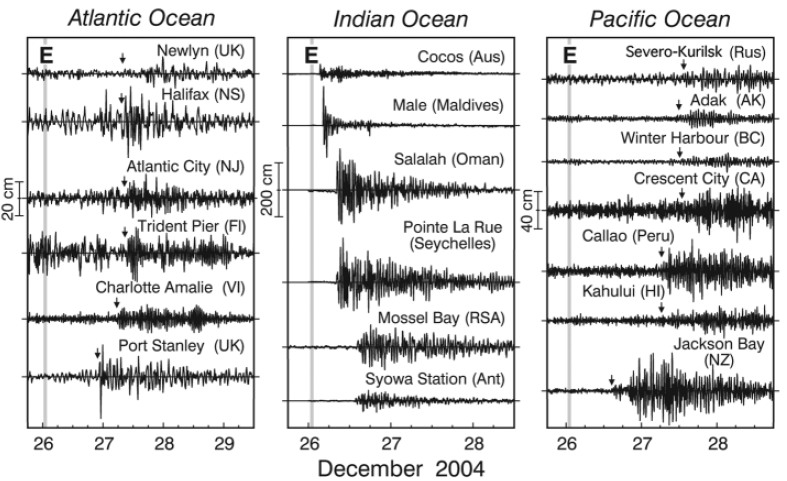
(2007): Sedimentary features of tsunami deposits - Their origin, recognition and discrimination: An introduction. (2003): Sedimentologic and geomorphologic tsunami imprints worldwide-a review. (2010): Historical and geological evidence of boulders deposited by tsunamis, southern Ryukyu Islands, Japan. (2007): Tsunami deposits in the geological record. Spektrum Akademischer Verlag, Berlin: 219ĭAWSON, A.G. (1995): Erdbeben - Schlüssel zur Geodynamik. University of Washington Press: 144īOLT, B.A. (2005): The Orphan Tsunami of 1700 Japanese Clues to a Parent Earthquake in North America.

The shores of continents are today densely populated areas - the study of the geologic effects and sediments of a tsunami can help to improve our records of prehistoric events and better define the risk for such areas.ĪTWATER, B.F. The research identified various trimlines in the area affected by the 2004 tsunami, dating back about 300 years.

A great advantage of such a stratigraphic succession is the possibility to date the organic remains with the radiocarbon dating method and produce exact prehistoric chronologies of these changes.Ī paper published in 2009 analyzes the use of trimlines, the limits of the area devastated and eroded by the tsunami, to map the extent of a tsunami. These changes can be observed in the stratigraphic succession: layers of peat or soil with fossil trees will change suddenly to layers of sand, deposited by the tsunami and the tides. Slowly the land will rise again due the continuing tectonic movements. The trees of these " Ghost forests" are finally buried in the sediments of the tidal flat. The salt water soon will kill trees and plants growing there. There is also indirect biological (apart marine fossils found on land) evidence for a tsunami.Ī strong earthquake can cause not only a tsunami but can also lower the coastal area below sea level. A boulder transported by a catastrophic tsunami during the eruption of Krakatoa in 1883 (image in public domain). Large megaclasts found along the cliffs of the Irish Aran-Island, ranging in weight from 20 to 230 tons and regarded as tsunami deposits, were reinterpreted in 2004 as boulders moved by strong storms coming from the Atlantic Ocean.įig.2. However also such boulders seem not to be always unequivocal evidence for a tsunami. In November 2007 a team of geophysicists from the University of Texas announced the discovery of possibly the largest tsunami transported boulders ever recorded. Such boulders are unlikely to be reworked by normal processes of a coastal environment and have a greater potential to become fossilized. A tsunami can also transport and deposit giant boulders (like reef debris). Also many features found in these layers (like grain-size distribution or the accumulation of marine fossils) are very similar to sediments deposited by storms. Unfortunately the preservation - potential for such sediments in an unstable environment like a beach is very low, explaining in part why until now tsunami are underrepresented in the geological record. The sediments of the uprush and backwash currents of a tsunami, consisting of thick sand layers, are described by this post at the " Trough The Sandglass" blog. The tsunami inundates the land and transported sediments and debris are deposited. Very schematic stratigraphic succession of tsunami - deposits. Also liquefaction phenomena, like sand dikes, can be preserved in the sediments underlying the tsunami deposits.įig.1. The peculiar (and controversial) " molar tooth structure", described along the unconformity of older sediments to tsunami sediments, is formed when vibrations of the earthquake crush older layers and the tsunami breaks off regular slabs of soil ( rip up clasts).

When the tsunami hits the coast it will first erode older sediments. In theory a tsunami can trigger a variety of erosion and depositional processes, like uprush and backwash currents, turbidity currents, debris flows and landslides, therefore also the formed sediments can vary from fine-grained sediments to large boulders. Modern databases list more than 2.000 tsunami events worldwide in the last 4.000 years, most of them recorded in historic documents, chronicles and even myths - and yet tsunami deposits in the geological record seem to be relatively rare. The tsunami of Indonesia 2004 and Japan 2011 showed that they are a common element associated with earthquakes.


 0 kommentar(er)
0 kommentar(er)
